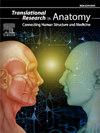不对称方前旋肌变异与逆行腱膜的生物力学参数和肌间比较
Q3 Medicine
引用次数: 0
摘要
旋前方肌(PQ)是前臂前房室深处的一块四边形肌肉,执行旋前和稳定远端尺桡关节(DRUJ)。尺侧常有薄而浅的肌腱膜。涉及生物力学参数和肌肉间可比性的非典型PQ形态的报道很少,尽管它们有助于理解PQ变异及其临床意义。因此,本研究的目的是研究不对称PQ变化与逆行腱膜的生物力学参数和肌间可比性。方法在常规人体解剖中发现2例不对称双侧PQ变异。用比例尺原位拍照,测量每块肌肉的解剖参数。通过光镜评估平均死后固定肌节状态,以计算每块肌肉的标准化最大等距力(Fmax)。计算每块肌肉之间的肌间结构相似性指数(δ2,1),以表明作为皮瓣/自体移植物组织的适宜性。结果左PQ远端肌(PQp; 3.81 g; Fmax = 2.22 N)、左PQ近端肌(PQp; 4.13 g; Fmax = 2.72 N)和右PQ远端肌(PQp; 6.97 g; Fmax = 4.16 N)在结构上无差异(0.30 < δ2,1 < 0.80)。然而,与右PQp (0.87 g; Fmax = 0.79 N)相比,这些肌肉在结构(δ2,1≥0.80)、大小和功能能力上均有显著差异。值得注意的是,每一对同侧变异PQ肌肉表现出肌腱腱膜的反转位置。结论PQ在许多外科手术中都有应用,包括掌侧(改良Henry)或切开复位内固定(ORIF)入路,用于桡骨远端骨折的手术修复。前臂远端慢性难治性肌筋膜疼痛和DRUJ骨关节炎可能需要鉴别评估PQ的变化。该报告可能为骨科医生、临床解剖学家和相关卫生专业人员在诊断和治疗PQ变异患者时提供新的重要见解。本文章由计算机程序翻译,如有差异,请以英文原文为准。
Biomechanical parameters and intermuscular comparability of asymmetrical pronator quadratus muscle variations with reversed tendon aponeuroses
Background
The pronator quadratus (PQ) is a quadrangular muscle deep in the anterior compartment of the forearm that executes pronation and stabilizes the distal radioulnar joint (DRUJ). A thin, superficial tendon aponeurosis is commonly present on its ulnar side. Reports of non-typical PQ morphologies involving biomechanical parameters and intermuscular comparability are scarce despite the important knowledge they would contribute to understanding PQ variations and their clinical implications. Thus, the purpose of this study is to investigate the biomechanical parameters and intermuscular comparability of asymmetrical PQ variations with reversed tendon aponeuroses.
Methods
A case of asymmetrical bilateral PQ variations was discovered during routine human cadaver dissection. The variations were photographed in situ with scale, and anatomical parameters of each muscle were measured. Mean postmortem fixed sarcomere states were evaluated via light microscopy to calculate a normalized maximal isometric force (Fmax) for each muscle. Intermuscular architectural comparability indices (δ2,1) were calculated between each muscle to indicate suitability as flap/autograft tissue.
Results
Despite differences in mass and Fmax, the left distal PQ muscle (PQd; 3.81 g; Fmax = 2.22 N), left proximal PQ muscle (PQp; 4.13 g; Fmax = 2.72 N), and right PQd (6.97 g; Fmax = 4.16 N) were architecturally indifferent (0.30 < δ2,1 < 0.80). However, each of these muscles were significantly different in structure (δ2,1 ≥ 0.80), size, and functional capability compared to the right PQp (0.87 g; Fmax = 0.79 N). Notably, each ipsilateral pair of variant PQ muscles exhibited reversed location of their tendon aponeuroses.
Conclusions
The PQ is encountered and utilized in many surgical procedures, including volar (modified Henry) or open reduction internal fixation (ORIF) approaches for surgically repairing a distal radius fracture. Chronic refractory myofascial pain in the distal forearm and DRUJ osteoarthritis may warrant differential evaluation for variations of the PQ. This report may provide new and important insights to orthopedists, clinical anatomists, and allied health professionals when diagnosing and treating patients with PQ variations.
求助全文
通过发布文献求助,成功后即可免费获取论文全文。
去求助
来源期刊

Translational Research in Anatomy
Medicine-Anatomy
CiteScore
2.90
自引率
0.00%
发文量
71
审稿时长
25 days
期刊介绍:
Translational Research in Anatomy is an international peer-reviewed and open access journal that publishes high-quality original papers. Focusing on translational research, the journal aims to disseminate the knowledge that is gained in the basic science of anatomy and to apply it to the diagnosis and treatment of human pathology in order to improve individual patient well-being. Topics published in Translational Research in Anatomy include anatomy in all of its aspects, especially those that have application to other scientific disciplines including the health sciences: • gross anatomy • neuroanatomy • histology • immunohistochemistry • comparative anatomy • embryology • molecular biology • microscopic anatomy • forensics • imaging/radiology • medical education Priority will be given to studies that clearly articulate their relevance to the broader aspects of anatomy and how they can impact patient care.Strengthening the ties between morphological research and medicine will foster collaboration between anatomists and physicians. Therefore, Translational Research in Anatomy will serve as a platform for communication and understanding between the disciplines of anatomy and medicine and will aid in the dissemination of anatomical research. The journal accepts the following article types: 1. Review articles 2. Original research papers 3. New state-of-the-art methods of research in the field of anatomy including imaging, dissection methods, medical devices and quantitation 4. Education papers (teaching technologies/methods in medical education in anatomy) 5. Commentaries 6. Letters to the Editor 7. Selected conference papers 8. Case Reports
 求助内容:
求助内容: 应助结果提醒方式:
应助结果提醒方式:


